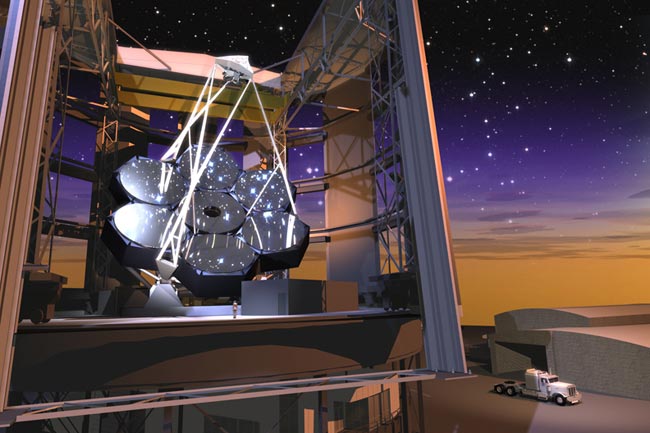Giant New Telescope Gets $50 Million In Funding

Plans for an enormous new telescopein Chile took a majorstep forward this week with a $50 million infusion from the UniversityofChicago to aid the observatory's construction.
The new observatory, called the GiantMagellan Telescope,is designed to detect objects 100 times fainter than those seen by theHubbleSpace Telescope. The University of Chicago funds will help cover theanticipated$700 million cost for the telescope, which astrophysicists hope will beable tocollect valuable data needed to make strides in understanding darkmatter anddark energy, the project's planners said.
The Giant Magellan Telescope willconsist of six circularmirrors, each 28 feet (8.4 meters) across, set in a flower-petalarrangementaround a seventh central mirror to make up the GMT's main mirror. Together,the mirrors form the equivalent of a nearly 82-foot (24.5-meter)telescope. Thenew telescope will be built at the Las Campanas Observatory in Chile,andshould take about seven years to complete.
While the Giant Magellan Telescopewon't beat out the world'slargest telescope currently planned — the 138-foot (42-meter)diameter EuropeanExtremely Large Telescope (E-ELT) currently under construction in themountainsof Chile'sAtacama desert — it is still expected to be one ofEarth'smost powerfullenses to study the heavens.
Dark matter and darkenergy are two central mysteries of modern cosmology. Thoughneither hasbeen detected directly, scientists suspect they exist because of theirperceived affect on the rest of the matter in the universe.
By gathering more observations of thedistant universe,astronomers hope to better understand these puzzling quantities. Thenewtelescope could play a major role in that quest, scientists said.
Researchersalso plan to use thetelescope to search for alienplanets orbiting around other suns.
Breaking space news, the latest updates on rocket launches, skywatching events and more!
"This is part of the goal of lookingfor Earth-likeplanets around other stars that could be the sites for life," saidEdward Kolb,chairman of the University of Chicago’s Department of Astronomy andAstrophysics. "This is one of the new avenues that the Giant MagellanTelescope will open, in addition to being able to look at the sky withunprecedented resolution and light-gathering power."
The total price tag for theinstrument will be split among itspartners: the Carnegie Institution for Science in Washington, D.C., theUniversityof Texas at Austin, Harvard University, Australian National University,Smithsonian Astrophysical Observatory, the University of Arizona, TexasA&MUniversity, Astronomy Australia Ltd., and the Korea Astronomy and SpaceScienceInstitute.
- Earth'sMost Important Telescopes
- The10 Most Amazing Hubble Discoveries
- Bigger,Better Space Telescopes Following In Hubble's Footsteps
Zoe Macintosh is a science writer who covered human spaceflight, astronomy and science for Space.com in 2010. She also covered general science for Space.com's sister site Live Science. Zoe studied English literature and physics at Smith College, where she also wrote for the Smith Sophian. Her work has also appeared in the National Association of Science Writers website.
